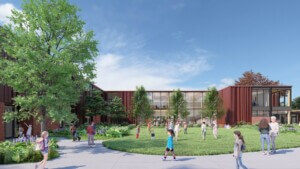This is an article from our special November timber issue.
The battle over the 2017 Timber Innovation Act is gaining momentum in Washington, D.C., where two new Senate sponsors and four new Congress members have signed on to it since this past May. The pending legislation would provide funding for research into innovative wood materials and mass timber structures above 85 feet. The bill’s proponents are hoping that it will be an impetus for transforming cities and towns across the country with a bevy of mid-rise and high-rise mass timber buildings.
“I am very impressed with the large cross-aisle support,” Chadwick Oliver, director of Yale University’s Global Institute of Sustainable Forestry, said. “You have Bruce Westerman, a Republican congressman from Arkansas and Peter DeFazio, a Democrat from Oregon who has been on the side of environmental groups. This looks like a bill that is quite serious about moving forward.”
However, the concrete and steel industries are vigorously lobbying to derail the legislation, and have established a website called Build with Strength that contains a detailed critique of the new generation of wood buildings. “It is a piece of legislation that props up one industry over another and we think that it is misguided and dangerous,” Kevin Lawlor, a spokesperson from Build with Strength, said. “We don’t think that it is safe in three-to-five story buildings, and we don’t think that it is safer in taller buildings.”
The wood products industry, the U.S. Forest Service, and other advocates claim that technological advances make the new generation of tall timber buildings more fire resistant. In fact, according to Dr. Patricia A. Layton, director of the Wood Utilization + Design Institute at Clemson University, that is because of the way it chars in a fire: By insulating its interior, an exposed wood beam can actually be structurally stronger than a steel one. “Steel loses its strength at a lower temperature than does wood,” she explained. “If you expose concrete or steel it is combustible, and it does feel the effects of fire.”
Many of the act’s supporters say that allowing buildings to be built from wood technologies such as cross-laminated timber (CLT) will result in a host of economic and environmental benefits. Most of the Timber Innovation Act’s sponsors hail from states where the wood industry is struggling to recoup from the recent housing downturn and also suffering from the decrease in demand for paper that is a result of the increasing digitalization of the economy.
“A big part of the innovation act is having the U.S. Forest Service work to expand markets and attract business to heavily forested states, particularly those that have a major timber industry,” said Andrew Dodson, vice president of the American Wood Council, who notes that the U.S. Timber Innovation Act is a way to help jumpstart a sagging wood-products industry. “Mills are running at much lower capacity,” he said, “two shifts versus three or four—we want to put more mill jobs back in place.”
However, some in the mass timber industry say that the Timber Innovation Act will be of limited utility until building codes are changed to allow for the use of CLT. “The code issue is more critical than the Timber Innovation Act,” Jean-Marc Dubois, director of business development for the Montreal-based Nordic Structures, said. He believes that New York City’s restrictive building codes have helped stall progress on tall timber, pointing to the wooden skyscraper designed by SHoP architects that was killed earlier this year as an example.
Even though the 2015 International Building Code (IBC), which New York City has not adopted, allows for the use of CLT, Dubois said that building departments throughout the country haven’t updated their codes to allow for the use of CLT. Having the SHoP project, which received a lot of publicity, fail to get built was a major setback for the industry, according to Dubois. “New York City had the ability to be a real-world leader with timber innovation,” he said. “It was disappointing.”
A $250,000 grant from the U.S. Forest Service’s Wood Innovations Grant program helped Yugon Kim of Boston-based IKD develop what he believes is the first hardwood CLT structure in the U.S.: An outdoor sculpture in Columbus, Indiana, which consists of a series of ascending arcing forms.
Congress is not the only place in Washington where the merits of tall mass timber are being explored. Steve Marshall, assistant director at the U.S. Forest Service, has been working with the International Code Council to develop standards for the use of CLT. In addition, the U.S. Department of Defense has been conducting blast tests with CLT to determine whether it is an appropriate material to use on its bases.
Marshall said there are other potential sources for government support for CLT projects aside from direct funding from the Timber Innovation Act. In the third week of October, his agency will be releasing a new round of grants of up to $250,000 under its Wood Innovations Grants program. Next year, the Forest Service is planning on making $8 million available under the same program, and applications will be due by mid-January.
One of the most notable examples of how government funding can play a difference is with LEVER Architecture’s innovative design of the 12-story (148-foot-tall) Framework building under construction in Portland, Oregon, which will be the first wood high-rise in the U.S.
A $1.5 million U.S. Tall Building Award sponsored by the U.S. Department of Agriculture helped fund the seismic and fire-safety tests that enabled it to pass muster with Portland building department officials.
Thomas Robinson, principal of LEVER Architecture said that the concrete and steel industries shouldn’t be worried about losing market share because in the future most tall timber structures will be hybrids that include concrete and steel as well as wood. “We need to look at each material for its appropriate purpose,” he said.










